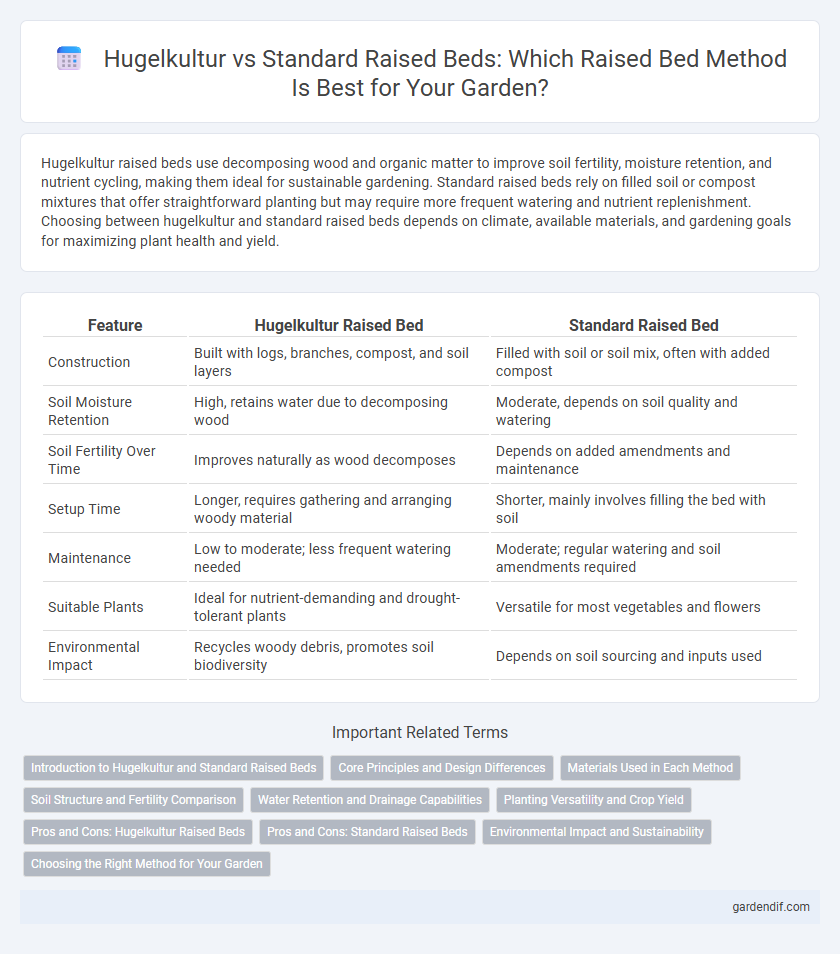
Hugelkultur vs Standard Raised Bed Illustration
Hugelkultur raised beds use decomposing wood and organic matter to improve soil fertility, moisture retention, and nutrient cycling, making them ideal for sustainable gardening. Standard raised beds rely on filled soil or compost mixtures that offer straightforward planting but may require more frequent watering and nutrient replenishment. Choosing between hugelkultur and standard raised beds depends on climate, available materials, and gardening goals for maximizing plant health and yield.
Table of Comparison
| Feature | Hugelkultur Raised Bed | Standard Raised Bed |
|---|---|---|
| Construction | Built with logs, branches, compost, and soil layers | Filled with soil or soil mix, often with added compost |
| Soil Moisture Retention | High, retains water due to decomposing wood | Moderate, depends on soil quality and watering |
| Soil Fertility Over Time | Improves naturally as wood decomposes | Depends on added amendments and maintenance |
| Setup Time | Longer, requires gathering and arranging woody material | Shorter, mainly involves filling the bed with soil |
| Maintenance | Low to moderate; less frequent watering needed | Moderate; regular watering and soil amendments required |
| Suitable Plants | Ideal for nutrient-demanding and drought-tolerant plants | Versatile for most vegetables and flowers |
| Environmental Impact | Recycles woody debris, promotes soil biodiversity | Depends on soil sourcing and inputs used |
Introduction to Hugelkultur and Standard Raised Beds
Hugelkultur is a sustainable gardening technique that involves building raised beds using decomposing wood and organic material to enhance soil fertility and water retention. Standard raised beds consist of soil contained within a defined frame, promoting better drainage, weed control, and soil structure management. Both methods improve plant growth, but Hugelkultur uniquely mimics natural forest processes with woody debris that gradually breaks down, enriching the soil over time.
Core Principles and Design Differences
Hugelkultur raised beds utilize decomposing wood and organic matter at their core to enhance soil fertility, water retention, and microbial activity, contrasting with standard raised beds that primarily use soil and compost without a woody core. The design of hugelkultur beds features a mound shape that maximizes surface area and promotes natural decomposition, while standard raised beds typically have flat, enclosed structures prioritizing soil depth and containment. Core principles of hugelkultur emphasize sustainable resource recycling and moisture conservation, whereas standard raised bed gardening focuses on soil control and ease of access for planting and maintenance.
Materials Used in Each Method
Hugelkultur raised beds utilize decomposing wood, branches, and organic debris as the primary base materials, which enhance soil aeration and moisture retention. Standard raised beds typically rely on soil, compost, and often imported topsoil layered within wooden, metal, or stone frames for structure and nutrient support. The organic matter in Hugelkultur breaks down over time, enriching the bed naturally, whereas standard raised beds require more frequent soil amendments to maintain fertility.
Soil Structure and Fertility Comparison
Hugelkultur raised beds improve soil structure by incorporating decomposing wood and organic materials that increase aeration, moisture retention, and microbial activity compared to standard raised beds filled primarily with soil and compost. The slow decomposition of woody material in hugelkultur beds releases nutrients gradually, enhancing long-term soil fertility, whereas standard beds rely more on external fertilizers and frequent amendments. This natural nutrient cycling in hugelkultur systems supports sustained plant growth and soil health over multiple growing seasons.
Water Retention and Drainage Capabilities
Hugelkultur raised beds excel in water retention due to their core of decomposing wood, which acts like a sponge, slowly releasing moisture to plants while improving soil aeration. Standard raised beds rely on well-draining soil mixes that prevent waterlogging but require more frequent irrigation in dry periods. The unique structure of hugelkultur beds balances moisture retention and drainage, reducing irrigation needs compared to standard raised beds with typical soil blends.
Planting Versatility and Crop Yield
Hugelkultur raised beds enhance planting versatility by utilizing decomposing wood and organic matter, creating nutrient-rich, moisture-retentive soil suitable for diverse crops. Standard raised beds offer controlled soil quality and easier maintenance but may require frequent watering and fertilization to match hugelkultur's natural nutrient cycling. Crop yield in hugelkultur beds often surpasses standard raised beds due to improved soil structure and long-term fertility, supporting robust plant growth and higher productivity.
Pros and Cons: Hugelkultur Raised Beds
Hugelkultur raised beds use decomposing wood and organic matter to improve soil fertility, moisture retention, and nutrient cycling, making them ideal for drought-prone areas. They require less frequent watering and slowly release nutrients but can initially tie up nitrogen during decomposition and may attract pests like termites. Compared to standard raised beds, hugelkultur beds offer enhanced soil biodiversity but involve more labor and time to establish.
Pros and Cons: Standard Raised Beds
Standard raised beds offer enhanced soil control, improved drainage, and easier access for planting and maintenance, making them ideal for urban gardening and small spaces. Their straightforward construction and use of imported soil provide predictability in nutrient management but may require more frequent watering compared to Hugelkultur beds. However, traditional raised beds lack the organic decomposition benefits and extended moisture retention provided by the wood and organic matter layers in Hugelkultur methods.
Environmental Impact and Sustainability
Hugelkultur raised beds enhance environmental sustainability by utilizing decomposing wood and organic matter, which improves soil moisture retention and reduces the need for irrigation. Standard raised beds often rely on imported soil and synthetic amendments, increasing the carbon footprint associated with sourcing and transportation. Hugelkultur's natural nutrient cycling and waste reduction contribute to long-term soil health and lower environmental impact compared to traditional raised bed systems.
Choosing the Right Method for Your Garden
Hugelkultur raised beds, which incorporate decomposing wood and organic matter, improve soil fertility, moisture retention, and nutrient cycling compared to standard raised beds filled with traditional garden soil or compost. Gardeners seeking enhanced water efficiency and long-term soil enrichment benefit from hugelkultur's ability to mimic natural forest floor processes. Standard raised beds offer easier construction and immediate planting readiness, ideal for gardeners prioritizing simplicity and quick crop turnover.
Hugelkultur vs Standard Raised Bed Infographic

 gardendif.com
gardendif.com